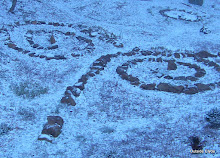
Out in the full sun colors abound. Leaf textures start to blend into monotony. Flowers shapes and colors help tell you who is who.

As big as a dinner plate, this round white form stood out on the forest floor.

White Wood Aster, Eurybia divaricata managed to find a spot to bloom along the edge of a stream.

Solid mats of ferns cover huge swaths of sloped ground.

How these streams were not full after two weeks of steady rain is a mystery to me. I just came from a desert though, so my idea of steady rain may be some what off.

A short 1.8 mile hike took quite some time. There was a lot to see and examine.
Green-Headed Coneflower, Rudbeckia laciniata growing in huge patches five feet tall were just beginning to bloom.

Heal-All, Prunella vulgaris carpeted the ground in spots.

There tends to be more sun on the top of things. Some where down there is where we walked six miles.

Eupatorium fistulosum or E. maculatum, who knows the Joe Pye Weed. The E. fistulosum is said to have hollow stems. It may have lower down than I have looked so far. Mid way it has a white inner pith.
In the background is the renamed Turkscap Lily, Lilium superbum not Lilium lancifolium that I have been calling it. There is some incredibly subtle difference to distinguish the two that I will pay attention to at some point.

Spotted Knapweed a relative of Bachelors Button, Centaurea biebersteinii or maybe it has been renamed to C. stoebe. After searching for several hours on the identity of this pretty wild flower it was a little disappointing to find out it has been declared a noxious weed. The place I first found it does not bode well for control. Then I was told it grows all along the interstate. A little research once I had ID'd it and it has spread across the whole country. Is there a point at which a plant is declared indigenous?

Looking in the other direction.

Mountain Mint, Pycnanthemum something. I have not been able to find a species name for this yet. I may not even have the genus right.

At the end of the short hike there was something to climb.

Featherbells, Stenanthium gramineum is in the Liliaceae family. It has very grass like non-descript foliage. The flower spike is very dramatic. This picture does not do it justice.

Getting a little closer to the sun.

Fire Pink, Silene virginica is so very red.

And those were just a few of the wild flowers we all saw on the short hike.
Now back to the trenches for the footings for my cabin. Today they were cleaned of roots, the bottoms eyeball leveled and smoothed and measurements were taken for all the batter boards.






7 comments:
Just beautiful.
Is the green-headed coneflower a native? I have the giant one, which I like, but it's almost too much - to tall and too quick and showy - this one looks more subtle and it's a wonderful color.
Yes the Rudbeckia laciniata is a US native. It is also called the Cutleaf Coneflower because the leaves are deeply lobed. There is a big patch of it across the street from me along the road.
Is the giant one you have with a very silver green smooth leaf, almost looks like a waxy coating, that gets up to six feet or more? There is one of those here recovering from a burial when my road was cut.
No need to buy a nursery plant ever again! Seeds and cuttings, all the way.
Are you going to collect some seeds for us?
I just learned southern California has a native rudbeckia too. Apparently, it's very rare.
And I just bought three Catananche caerulea at Lowes today. Tomorrow I might buy some Northern Sea Oats Grass. I needed something to make me feel good.
If I don't collect seeds I can steal them from my mother, but if you have a specific plant you see that you want let me know. Seeds are easy to mail, I think.
Be aware the Northern Sea Oats has a well deserved reputation for spreading. I have some since it's supposed to be good for soil stabilization in rain gardens, and at 2 yrs old I am already pulling out numerous seedlings. I will experiment with cutting off the seed heads early this fall.....
I first became familiar with Rudbeckia laciniata last spring at the NC Botanical Garden branch in Chapel Hill, where I purchased one. I love it!
P. muticum, isn't it? Broad or big leaf mountain mint. Love it.
Mary, the mint was identified as Pycnanthemum incanum, Hoary Mountain Mint. I really need to go have another closer look to be %100 sure, but I think that is right. The flowers were more pink/lavender and only the top leaf bracts had the silver coloring. The P. muticum looked to have an overall grey/green leaf to the whole plant and white flowers.
Post a Comment